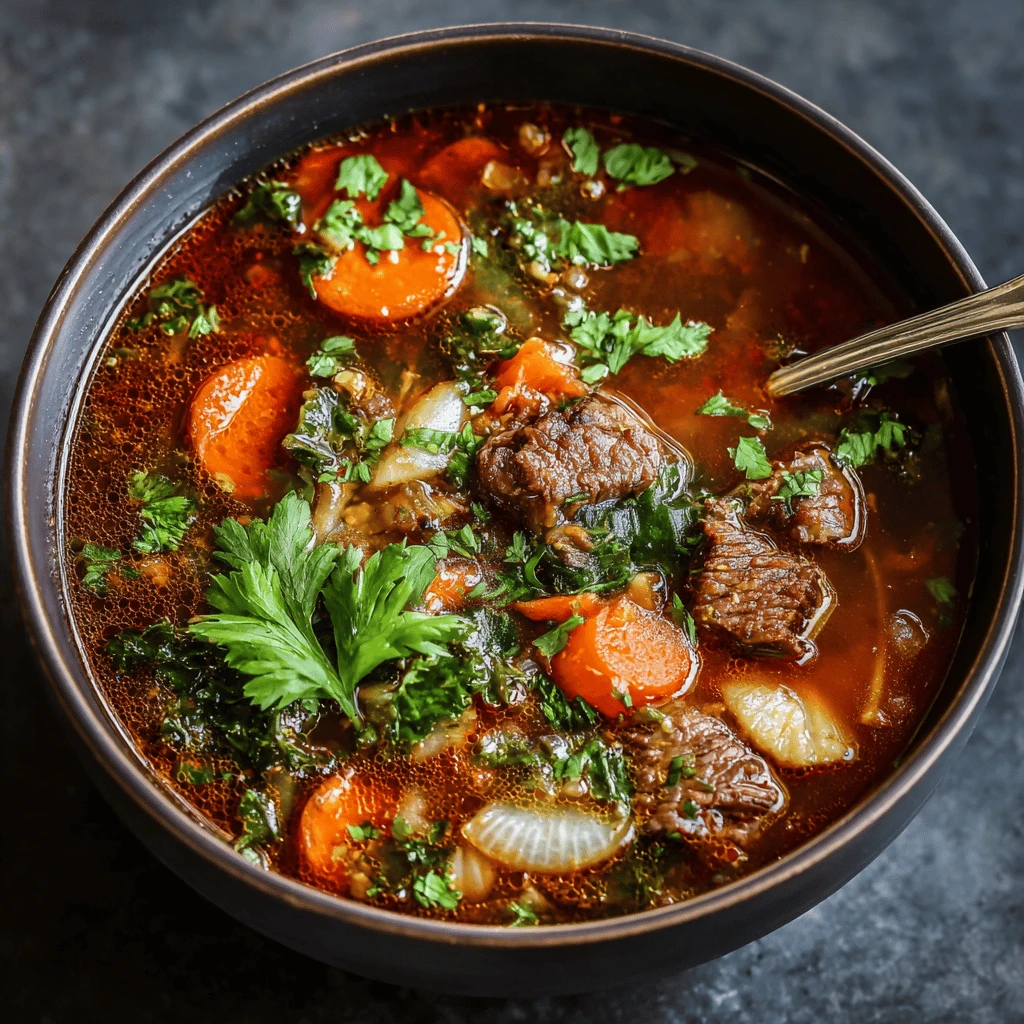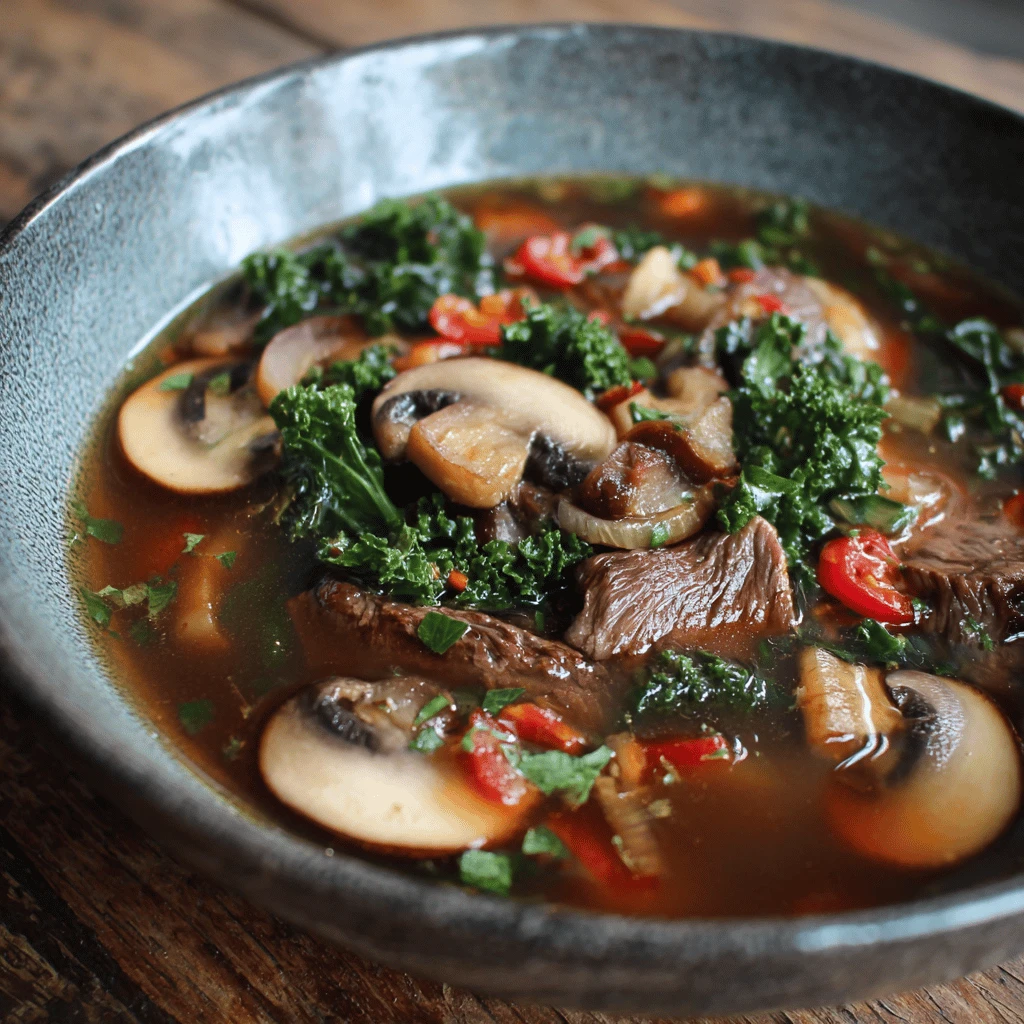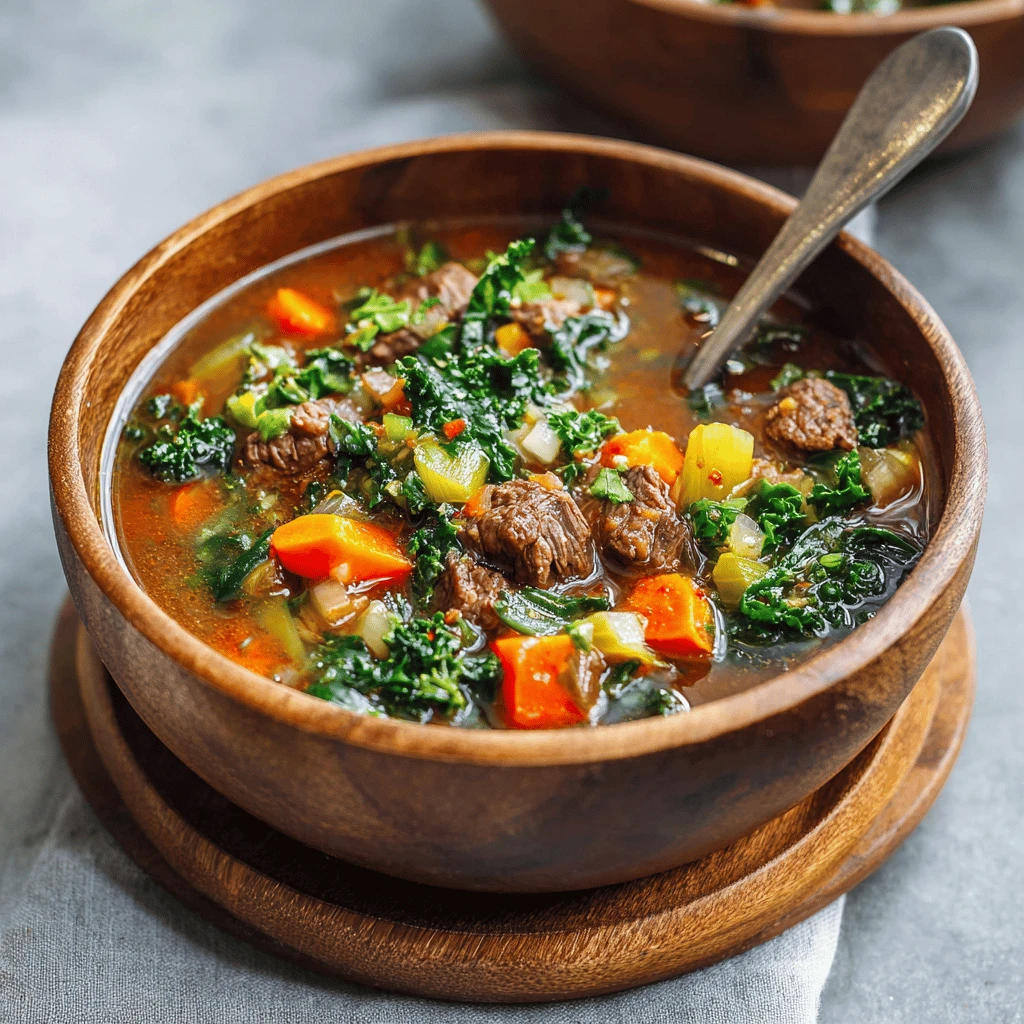Healthy Beef Feel-Better Soup
Nothing says comfort quite like a warm bowl of soup, especially when you’re feeling under the weather. This Healthy Beef Feel-Better Soup is a nourishing and delicious way to soothe your body and soul. Packed with lean protein, wholesome vegetables, and flavorful broth, it’s a powerhouse of nutrients designed to help you recover and get back on your feet.
The Power of Beef Broth and Why It Works
At the heart of this feel-better soup is a rich and comforting beef broth. But what makes beef broth so beneficial when you’re feeling unwell?
- Nutrient Density: Beef broth, particularly when made from bones, is loaded with collagen, amino acids, and minerals like potassium, magnesium, and calcium. These nutrients are easily absorbed and can help support your body’s natural healing processes.
- Gut Health: The gelatin in bone broth can help soothe and repair the gut lining. A healthy gut is crucial for overall immunity and nutrient absorption, making it a key component in feeling better faster.
- Hydration: Staying hydrated is essential when you’re sick. Warm broth provides a delicious and comforting way to increase your fluid intake and prevent dehydration, which can exacerbate symptoms like headaches and fatigue.
- Anti-Inflammatory Properties: Certain amino acids found in beef broth, such as glycine and proline, have anti-inflammatory properties that can help reduce swelling and discomfort associated with illness.
While you can use store-bought beef broth, making your own from bones enhances the benefits and allows you to control the sodium content. Roasting the bones beforehand adds depth of flavor to the broth.
Building a Nutrient-Rich Foundation: Key Ingredients
Beyond the broth, the ingredients you add to your soup play a vital role in its feel-good properties. Here are some key components and their specific benefits:
- Lean Beef: Opt for lean cuts of beef like sirloin or round steak. Beef provides essential protein, iron, and zinc, all of which are crucial for immune function and energy production. Cut the beef into bite-sized pieces for easy eating.
- Root Vegetables: Carrots, parsnips, and turnips are excellent choices. They are packed with vitamins, minerals, and fiber, supporting digestive health and providing sustained energy. The sweetness of carrots also adds a pleasant flavor to the soup.
- Onions and Garlic: These aromatic vegetables are immune-boosting powerhouses. Garlic contains allicin, a compound with antiviral and antibacterial properties. Onions are rich in antioxidants that help fight inflammation. Sauté them gently to release their flavors before adding other ingredients.
- Celery: Celery adds a subtle savory flavor and is a good source of vitamins A, C, and K, as well as folate and potassium. It also provides fiber, contributing to digestive health.
- Mushrooms: Add sliced crimini or shiitake mushrooms for an earthy flavor and a boost of nutrients. Mushrooms are rich in selenium and B vitamins, which are important for immune function and energy metabolism.
- Fresh Herbs: Parsley, thyme, and rosemary add freshness and flavor while providing antioxidant benefits. Parsley is a good source of vitamins A and C, while thyme and rosemary have antimicrobial properties.
Don’t be afraid to customize the ingredients based on your preferences and what you have on hand. Other additions like spinach, kale, or bell peppers can further enhance the nutrient content of your soup.
From Simmer to Satisfaction: Step-by-Step Recipe
This recipe is designed to be simple and adaptable. Feel free to adjust the quantities of ingredients based on your preferences and the size of your pot.
Ingredients:
- 1 tablespoon olive oil
- 1 pound lean beef (sirloin or round), cut into bite-sized pieces
- 1 large onion, chopped
- 2 cloves garlic, minced
- 2 carrots, peeled and chopped
- 2 celery stalks, chopped
- 1 parsnip, peeled and chopped (optional)
- 8 cups beef broth (homemade or low-sodium store-bought)
- 1 teaspoon dried thyme
- 1/2 teaspoon dried rosemary
- 1 bay leaf
- Salt and pepper to taste
- 1 cup cooked rice or egg noodles (optional)
- Fresh parsley, chopped, for garnish
Instructions:
1. Sear the Beef: Heat olive oil in a large pot or Dutch oven over medium-high heat. Add the beef and sear on all sides until browned. Remove the beef from the pot and set aside.
2. Sauté the Aromatics: Add the chopped onion and garlic to the pot and sauté until softened, about 5 minutes.
3. Add Vegetables: Add the carrots, celery, and parsnip (if using) to the pot and cook for another 5 minutes, stirring occasionally.
4. Combine Ingredients: Return the beef to the pot. Pour in the beef broth and add the thyme, rosemary, and bay leaf. Season with salt and pepper to taste.
5. Simmer: Bring the soup to a boil, then reduce the heat to low, cover, and simmer for at least 1 hour, or up to 2 hours, until the beef is tender and the vegetables are cooked through.
6. Add Noodles (Optional): If using rice or egg noodles, add them to the soup during the last 15 minutes of cooking.
7. Serve: Remove the bay leaf before serving. Garnish with fresh parsley.
Tips for Success:
- Don’t Rush the Simmer: Simmering the soup for a longer period allows the flavors to meld together and the beef to become more tender.
- Adjust Seasoning: Taste the soup throughout the cooking process and adjust the seasoning as needed.
- Make Ahead: This soup can be made ahead of time and stored in the refrigerator for up to 3 days or in the freezer for up to 3 months.
- Customize Your Soup: Feel free to add other vegetables like potatoes, sweet potatoes, or peas. You can also add a squeeze of lemon juice or a dash of hot sauce for extra flavor.
Boosting the Feel-Good Factor: Beyond the Soup
While this soup is a fantastic remedy for feeling under the weather, there are other things you can do to support your recovery:
- Rest: Getting plenty of rest is crucial for allowing your body to heal. Aim for at least 8 hours of sleep per night.
- Hydration: Drink plenty of fluids, such as water, herbal tea, or electrolyte drinks, to stay hydrated.
- Steam Inhalation: Inhaling steam can help relieve congestion. Add a few drops of eucalyptus or peppermint oil to a bowl of hot water and inhale the steam for 10-15 minutes.
- Over-the-Counter Medications: Consider using over-the-counter medications like pain relievers or decongestants to manage symptoms.
- Consult a Doctor: If your symptoms are severe or persist for more than a few days, consult a doctor to rule out any underlying medical conditions.
Remember, feeling better is a holistic process that involves nourishing your body with nutritious foods like this soup, getting adequate rest, and taking care of your overall well-being.
Frequently Asked Questions (FAQ)
-
- Can I use ground beef instead of stew meat?
Yes, you can use lean ground beef. Brown it thoroughly before adding the other ingredients. Ground beef will result in a slightly different texture, but it works well in a pinch.
-
- Can I make this soup in a slow cooker?
Absolutely! Brown the beef and sauté the vegetables as directed in the recipe. Then, transfer everything to a slow cooker and cook on low for 6-8 hours or on high for 3-4 hours.
-
- How long does the soup last in the refrigerator?
The soup will last for 3-4 days in the refrigerator when stored in an airtight container.
-
- Can I freeze this soup?
Yes, this soup freezes well. Allow it to cool completely before transferring it to freezer-safe containers or bags. It can be stored in the freezer for up to 3 months.
-
- Is this soup suitable for children?
Yes, this soup is generally suitable for children, but make sure the ingredients are cut into small, manageable pieces. Consult with your pediatrician if you have any concerns about allergies or dietary restrictions.
-
- Can I add other types of beans or legumes?
Adding beans or lentils can increase the fiber and protein content of the soup. Add them during the last 30-45 minutes of cooking to prevent them from becoming mushy.
-
- What can I substitute for beef broth?
If you don't have beef broth, you can use chicken broth or vegetable broth. However, beef broth provides a richer, more robust flavor that complements the beef.




